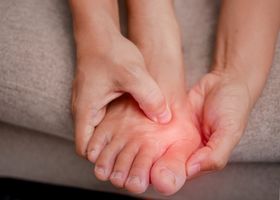Heel Pain and Golf
Updated October 7, 2024.

The most common foot complaint I have seen is heel pain, and golfers are no different.
However, heel pain is not a medical diagnosis, and I often find that the cause of the pain in the golfing foot is different from other groups of patients. The most overused self-diagnosis is plantar fasciitis, with heel spurs running a close second. On examination, however, these diagnoses are far less common.
The Most Common Causes of Heel Pain
Plantar enthesopathy, where the tendon of the Flexor hallucis muscle and the medial slip of the plantar aponeurosis attaches to the heel bone, and calcaneal hyperostosis (severely bruised heel syndrome) are most common. In fact, these two will often be present at the same time if the heel pain has been left untreated for a long time.
More severe causes of heel pain, especially around the inside of the ankle, are also often seen. The usual culprit is PTTD (posterior tibial tendon dysfunction), as golf adds another stress level to this muscle and tendon. With the foot being fixed on the ground when taking a shot, this muscle will often have to work much harder to support the arches of the foot and prevent them from collapsing. This extra load leads to tendon damage that can be significant and take months to heal.
The original cause of the problem is often not apparent, but careful questioning will usually lead to a culprit being identified. For example, a change in shoe manufacturer or model, an increase in activity (more golf), a job change, or simply a minor, once-off injury from climbing ladders or standing on a sharp rock will usually be responsible.
Best Treatments for Heel Pain
The treatment plan will include Golf Custom Orthotics, changes in footwear, and exercises for the foot, legs, and hips. In extreme cases, the body needs total rest and special immobilization boots, like those used when a fracture has occurred. These will be used to give the body a chance to start the healing process.
The take-home message is to make sure you get a diagnosis as soon as possible, as this will often lead to a much quicker and long-term resolution so you can get back to enjoying your golf.








